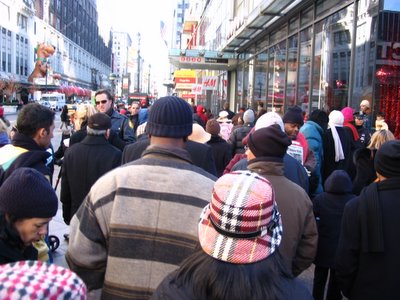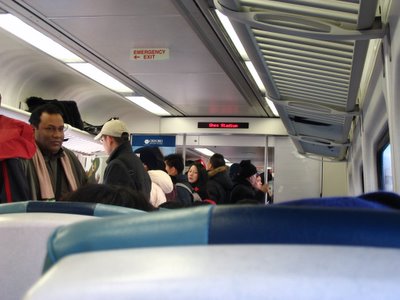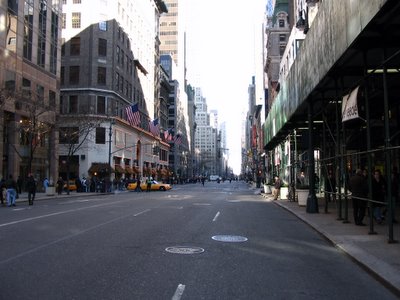Tuesday, December 20, 2005
Rats!

While the subways are out of commission, I can't help but wonder what's happening to the system-wide rat population. Are they roaming the tracks with reckless abandon? How are they keeping warm without the periodic rush of heated trains? How will they eat without the emoluments of muffin crumbs dropped from the clumsy digits of morning commuters?
Maybe they're forming a union as we speak and will be willing to work for less than a living wage!?
Who's Hungry?
When I heard this morning that the "inbound" delays from New Jersey were even longer than usual, it got me thinking: what happens to our food, Manhattan, while it sits in trucks on approaches from New Jersey? With delays of more than an hour at the George Washington Bridge and at the Lincoln Tunnel, vehicles waiting to get into Manhattan were forced to sit in a cold soup of exhaust. Although food transport vehicles most likely have environmental control systems, and the weather was likely cold enough to prevent anything from spoiling, what happens to all of the fumes that get sucked into the ventillation systems of these vehicles? Does it get pumped into refrigerated cargo holds? Does it then somehow penetrate the meats, poultry, vegetables, and other unprocessed foods? Can food purveyors distinguish themselves by highlighting the filtration systems used on their food transport fleet?
Granted, this phenomenon is not unique to New York -- as of 2003, the average food item in the US was purported to have journeyed 1500 miles before reaching your plate -- but idling in traffic before reaching the destination store or restaurant is something that affects anything waiting to enter Manhattan.
I think I've lost my appetite.
Granted, this phenomenon is not unique to New York -- as of 2003, the average food item in the US was purported to have journeyed 1500 miles before reaching your plate -- but idling in traffic before reaching the destination store or restaurant is something that affects anything waiting to enter Manhattan.
I think I've lost my appetite.
Strikes and Silence
More than anything, what's immediately noticeable about Manhattan during a transit strike is the silence that descends upon the city streets while it's in progress. The conspicuous lack of busses (and vehicles on certain avenues) makes for an eerie stillness. All one can hear are the steady footfalls of thousands of freezing pedestrians hurrying down the street.
Sunday, December 18, 2005
Borders and Exurbs
On Sunday, December 18th, the New York Times published two fascinating articles about related issues in different parts of the nation. In the National Report, Rick Lyman's "In Exurbs, Life Framed By Hours Spent in the Car," discussed the exigencies of congestion-plagued residents of burgeoning towns just north of Dallas. In the Long Island section, "The Defining Line: Examining Exactly Where Long Island Begins," Richard Korman takes readers on an excruciatingly specific journey down the 15.5 mile border which separates Nassau from Queens.
In both places, borders did not really interfere in most residents' lives. On Long Island, however, borders featured prominently in some residents' very identity. Perhaps the official demarcation of New York City's end is more significant to Islanders because New York City is more of a "destination" than Dallas. But at the same time, the stories told in Texas seem nearly impossible to tell on Long Island. Massive exurban migration from Dallas enables people to change their lifestyles, living in larger houses with only one couple working, sacrificing only longer commutes and "urban identities" for a more family-oriented life. This migration and exurban development much resembles the lifestyles portrayed in "Desperate Housewives." Unfortunately, this seems like something of a fantasy, even in places are far-flung as Mount Saini, New York -- more than 50 miles from Manhattan.
The two articles are about settlement patterns, but they're also about the power of local politics and how counties can be transformed by the very people who inhabit them. The Texas example shows how a town of 2,000 can take on the characteristics of a city in short order, while the Long Island example demonstrates how the line between the city and "the Island" can be blurred to the extent that it is largely irrelevant, and in some places entirely unnoticeable and unmarked.
In both places, borders did not really interfere in most residents' lives. On Long Island, however, borders featured prominently in some residents' very identity. Perhaps the official demarcation of New York City's end is more significant to Islanders because New York City is more of a "destination" than Dallas. But at the same time, the stories told in Texas seem nearly impossible to tell on Long Island. Massive exurban migration from Dallas enables people to change their lifestyles, living in larger houses with only one couple working, sacrificing only longer commutes and "urban identities" for a more family-oriented life. This migration and exurban development much resembles the lifestyles portrayed in "Desperate Housewives." Unfortunately, this seems like something of a fantasy, even in places are far-flung as Mount Saini, New York -- more than 50 miles from Manhattan.
The two articles are about settlement patterns, but they're also about the power of local politics and how counties can be transformed by the very people who inhabit them. The Texas example shows how a town of 2,000 can take on the characteristics of a city in short order, while the Long Island example demonstrates how the line between the city and "the Island" can be blurred to the extent that it is largely irrelevant, and in some places entirely unnoticeable and unmarked.
Monday, December 12, 2005
"Man goes wrong way on highway for 11 miles"
"STRASBOURG, France (Reuters) - A Frenchman drove up a motorway in the wrong direction for 11 miles, crashing into five other vehicles and killing one person and injuring three others including two children, police said.
The 66-year-old man continued driving after his first two collisions Sunday in the hope of finding an exit off the A35 in eastern France, a police spokesman in the city of Strasbourg said."
Officially, he was not drunk... Right... I wonder what the definition of DWI is in France, anyway?
The 66-year-old man continued driving after his first two collisions Sunday in the hope of finding an exit off the A35 in eastern France, a police spokesman in the city of Strasbourg said."
Officially, he was not drunk... Right... I wonder what the definition of DWI is in France, anyway?
Wednesday, December 07, 2005
Friday, December 02, 2005
Traffic.com
They have done something magical with this domain! Perhaps the best traffic site I've seen yet! I particularly like the ability to sort "traffic hot spots" by "jam factor." Naturally, FDR Drive North between 42nd and 96th Streets, currently has the highest jam index (8.4). The scale ranges from (1, clear, to 10, jammed).









